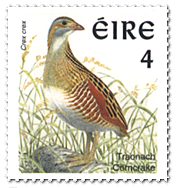
The Corncrake (Traonach) 4p
 Although fields of
corn are sometimes used by the Corncrake as breeding ground, it is most unusual to
actually see them. Years ago the bird nested in large numbers throughout Ireland and
England. Its grating call is like a stick been drawn across a notched piece of wood. I
have never heard a corncrake. I would not know its call even if I heard it because they
are so scarce around this part of the country.
Although fields of
corn are sometimes used by the Corncrake as breeding ground, it is most unusual to
actually see them. Years ago the bird nested in large numbers throughout Ireland and
England. Its grating call is like a stick been drawn across a notched piece of wood. I
have never heard a corncrake. I would not know its call even if I heard it because they
are so scarce around this part of the country.
The colour of the corncrake is brown and
blue and white and yellow and black dots. As recently as the 1950's these birds were to be
heard in virtually every meadow in Ireland. Early mowing of grass is the main problem as
it destroys corncrake eggs and chicks.
In some parts of the country farmers are been paid money not to cut their hay until late in the season to give the birds a chance to survive. The farmers are then asked to drive into the middle of the field and start cutting from the middle to the outside. This gives the young birds and their parents a chance to run into the ditches around the field, so the machinery won't kill them. Farmers would usually start cutting around the edge first. It doesn't live here all year round. It travels thousands of miles every year.
Although rarely seen, they are identified by their persistent , carke-carke call often heard deep into the night. You will not hear this bird very often so click on the stamp and listen to its call so you will recognise it, if you ever hear it in the wild.
The stamp was issued in Phase 2 on August 27th. 1997.
Researched and Written by --: Raphael Hogan
Click on the stamp
to hear the sound of the bird
![]()
![]()
![]()
![]()
![]()
![]()
![]()
![]()
![]()
![]()
![]()
![]()
![]()
![]()